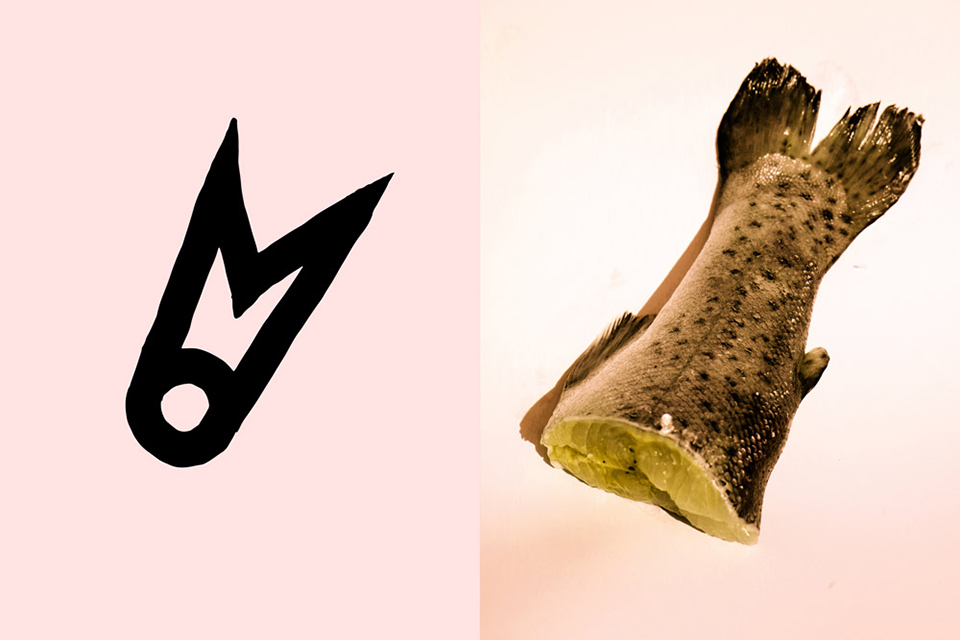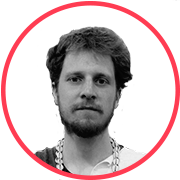
No Words: Tobias Gutmann — About a Self-Invented Visual Language
The first noticeable invention of Tobias Gutmann, a young Zurich-based artist, was a “Face-o-mat” — a machine, which gives you minimalistic portraits instead of soda or chocolate bars. They are made by Gutmann, who was actually in the “machine.” After it’s debut in Stockholm, the “Face-o-mat” went on tour to Japan, Tansania and all over Europe, and as a result, brought Tobias a gold medal in the Swedish illustration competition “Kolla!” and was nominated for the Swiss Design Awards in 2014.
A new Tobias Gutmann creation called “Let’s Make Language” is an artistic research project on abstract shapes, language and communication. Actually, he created a set of graphic symbols which differ from letters and hieroglyphs in that they make no sounds and do not string together into definite words. In this interview for Bird In Flight Gutmann explains his thoughts behind the work, why he combined type with music, and how the meaning of the symbols shift and change.

How did you create your symbols? What associations did you use?
I started with the impossible idea of drawing all possible shapes. I started from the dot, the smallest possible shape, and continued drawing bigger shapes. I drew most of my shapes without giving them a specific meaning. I was focusing on the visual diversity shapes in general, not on what they represented.
{“img”: “/wp-content/uploads/2014/11/the_evoltuion_of_shapes_tobias_gutmann.png”, “alt”: “Evolution of shapes by Tobias Gutmann”, “text”: “Evolution of shapes by Tobias Gutmann” }
But in the end, each of these symbols has some kind of meaning?
Everyone understands my symbols differently, and that’s where it gets interesting for me. I asked people what they see when they look at my abstract shapes. Within seconds everyone can tell what the shape represents. People usually mention artifacts, objects or animals, but some people have very personal connotations, for example a specific childhood memory.
What was the most unexpected meaning of a symbol?
I found out that when I turn certain shapes by just thirty degrees, people see different things. The shape stays the same, but it represents something totally different. On this right shape for example, most people saw something like a crown, a hat, a fox or a rabbit. And on the left shape, people saw something with movement — a shooting star, a badminton ball or a comet. I realized it is not only about the shape, but also how our brain interprets it.
{“img”: “/wp-content/uploads/2014/11/tobias_06.jpg”, “alt”: “Let’s Make Language magazine”, “text”: “Let’s Make Language magazine” },
{“img”: “/wp-content/uploads/2014/11/tobias_05.jpg”, “alt”: “Let’s Make Language magazine”, “text”: “Let’s Make Language magazine” },
{“img”: “/wp-content/uploads/2014/11/tobias_01.jpg”, “alt”: “Let’s Make Language magazine”, “text”: “Let’s Make Language magazine” },
{“img”: “/wp-content/uploads/2014/11/tobias_02.jpg”, “alt”: “Let’s Make Language magazine”, “text”: “Let’s Make Language magazine” },
{“img”: “/wp-content/uploads/2014/11/tobias_03.jpg”, “alt”: “Let’s Make Language magazine”, “text”: “Let’s Make Language magazine” },
{“img”: “/wp-content/uploads/2014/11/tobias_04.jpg”, “alt”: “Let’s Make Language magazine”, “text”: “Let’s Make Language magazine” },
{“img”: “/wp-content/uploads/2014/11/tobias_07.jpg”, “alt”: “Let’s Make Language magazine”, “text”: “Let’s Make Language magazine” },
{“img”: “/wp-content/uploads/2014/11/tobias_08.jpg”, “alt”: “Let’s Make Language magazine”, “text”: “Let’s Make Language magazine” },
{“img”: “/wp-content/uploads/2014/11/tobias_09.jpg”, “alt”: “Let’s Make Language magazine”, “text”: “Let’s Make Language magazine” },
{“img”: “/wp-content/uploads/2014/11/tobias_10.jpg”, “alt”: “Let’s Make Language magazine”, “text”: “Let’s Make Language magazine” },
{“img”: “/wp-content/uploads/2014/11/tobias_11.jpg”, “alt”: “Let’s Make Language magazine”, “text”: “Let’s Make Language magazine” },
{“img”: “/wp-content/uploads/2014/11/tobias_12.jpg”, “alt”: “Let’s Make Language magazine”, “text”: “Let’s Make Language magazine” }
What is the main aim of your “Let’s Make Language” project?
The project started with a general interest in abstract shapes. I wanted to find out what their meaning was and what I could say with my abstract shapes. During the process I started to question shapes, that I thought were very clear in what they represented, for example the symbol of a house. I realized that the meaning of this symbol differed, to what it actually represented visually.
With my project I do not aim to replace any other language, neither do I want to teach the world a new visual language. I want to question how we understand images in general. In our education we spent a lot of time learning languages, but learning how to understand images should be equally important.
Is your project artistic or scientific?
I don’t want to place it too much in a category, I call it an artistic research project. But I think the discussion around the topic should not be limited to an art context.
How will you develop the project?
After researching “Let’s Make Language” for about eight months, I am now looking for interesting new contexts to continue the project. I have developed an alphabet like an instrument. Now I want to speak my language, always with the goal to continue exploring the world and discovering new things.
Which program did you use for coding your language?
It is programmed as a typeface, but instead of the alphabet I added my own shapes. Since my project questions norms of language, I wanted to “misuse” the computer keyboard. When I started writing with my symbols, it felt like they were dancing. They had a rhythm and reminded me of music, so I connected them to a guitar and a piano, and started speaking visually with musical instruments.
Can we predict the result of typing?
Yes, if you know the language. For example, the worm. When you press one letter you have the first check of the worm. If you press the same letter twice it replaces with the second worm, and if you just go on pressing, it moves forward. I call it “animated type.” A typeface in it’s traditional form is usually very static. With my animated type, I add the dimension of time.
{“img”: “/wp-content/uploads/2014/11/tobias_animation_02.gif”, “alt”: “A worm symbol”, “text”: “A worm symbol” }
Did you try to transfer verbs or adverbs into your language?
My language is not structured in nouns, verbs and adjectives. Let’s get back to “the worm” it’s neither a noun, nor a verb. It`s an animation – an action or even a whole story with a beginning and an end.
Did you think about teaching small children to understand the symbols and the visual language?
Up to now it`s actually the opposite. Rather than me teaching children, I was learning from them. Children up to a certain age are not stuck within the norms of language. When I asked them to draw a house, they were not bound to the stereotypical symbol of the house, like most adults. So we should be more careful in how we teach children to draw.
{“img”: “/wp-content/uploads/2014/11/tobias_animation_01.gif”, “alt”: “A house symbol”, “text”: “A house symbol” }
What are you going to work on next?
I will have some exciting new “Face-o-mat” journeys. The next big performance will be in Melbourne, in February next year. It’s very inspiring to meet new people and get to know different cultures. Besides “Face-o-mat,” I’m also planning some new exhibitions, but I can’t say too much about that yet.
New and best




